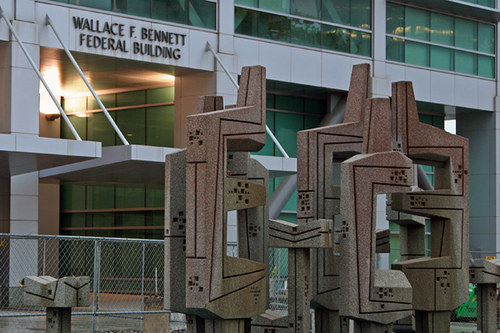High-Performance Real Estate with Existing Buildings: The Bennett Federal Building
Project Background
The Wallace F. Bennett Federal Building is located in the Central Business District within Salt Lake City and is the largest GSA owned property in Salt Lake City. The building was named after U.S. Senator Wallace F. Bennett (1898-1993), who represented Utah from 1951-1975. The Bennett Federal Building was constructed in 1963 of pre-formed/pre-stressed concrete panels in a design typical for federal buildings of that era. GSA renovated the eight-story office building in 2001, upgrading the seismic design features to ensure a safe, durable workplace. An energy efficient curtain wall system allows more natural light to enter the building.
The building has two floors below and seven floors above ground. Over 500 employees from 24 federal agencies occupy this facility. These agencies provide extensive services to the surrounding community as well as other city, county, state and national communities. The primary tenants in the Bennett Federal Building are: The Bureau of Reclamation, the National Oceanographic & Atmospheric Administration, Defense Contract Management Administration, and the Social Security Administration.
Hard Work Pays Off
The Rocky Mountain Region GSA identified the Bennett Federal Building as a prime candidate to meet the Guiding Principles, achieve LEED-EB certification, and improve the environmental and economic performance of the building. A Guiding Principle/LEED-EB gap analysis was performed on a subset of R8’s building inventory and the Bennett Building met the majority of the LEED-EB prerequisites and had the potential to meet enough credits to achieve certification. There was a learning curve familiarizing team members with the Volume Certification tool and documentation requirements, however it has been an educational opportunity that is already realizing operational improvements. The property managers, contractors and team members involved in the program are serving as sustainability leaders among their peers. One of the primary lessons learned on this project was streamlining the documentation process as well as building upon existing relationships to maximize the team dynamics and meet sustainability goals. In line with GSA’s top priorities, the team focused on reducing energy and water consumption while increasing waste diversion.
Identified Projects
The team identified projects that, when implemented, will reduce energy consumption by 868,469 kWh per year. The potential projects include:
- optimizing hot water pumping
- replacement of water plumbing fixtures to low flow fixtures
- upgrading lighting controls
- control system optimization
- upgrading lower efficiency motors, and
- upgrading to high efficiency transformers.
The project has a simple payback under five years with anticipated savings of nearly $246,000 per year.
Previusly Implemented Projects
Previously implemented energy project projects are saving the building 141,609 kWh per year. These projects included:
- a P.C. shutdown program to turn off all I.T. equipment saving 7,421 kWh or 2.89 MtCO2e/ year
- motors upgrades with a goal of 21,145 kWh reduction in energy resulting in GHG reduction of 8.4 MtCO2e/year
- a tenant lighting shutdown program yielding a savings of 28,175 kWh/year and reducing GHG by 10.98 MtCO2e/year
- sealing the building envelope stopping infiltration resulting in a savings of 82,345 kWh/year and GHG reduction of 32.07MtCO2e/year, and
- LED lighting in some common areas, elevators and bathrooms, saving 2,522 kWh/year or 1.0 MtCO2e.year.
In order to meet the LEED Water Efficiency prerequisite, the team implemented a plumbing fixture retrofit project. This included retrofitting bathroom faucet aerators and some flushometers with lower-flow models. The new fixtures replace the traditional water closets (3 GPF), urinals (2 GPF), and restroom faucets (1 GPM) with low-flow alternatives (1.28 GPF, 0.25 GPF, and 0.5 GPM respectfully). The building maintains a growing recycling program and offers a single stream recycling program that allows occupants greater opportunity to recycle waste items. A waste audit completed in April 2013 found the calculated waste diversion rate was 69% which is above the required 50% diversion rate in current federal regulations and standards. This building is also participating in GSA’s rapid recommissioning program which will utilize utility data and advanced metering to improve the building’s energy efficiency.
GSA Green Teams
Engaged building tenants are key to a successfully reducing a building’s energy use. GSA looks to implement Green Teams in its federal buildings to engage its customers in ongoing sustainability efforts. A Green Team is a voluntary group of building tenants who work together to reduce the government’s environmental footprint, ensure a healthy working environment and enlist building occupants as partners in sustainable business practices. For more than two years, the Bennett Building has had such a team at work, meeting on a quarterly basis.
Green Teams address issues like waste reduction, energy and water use, greening the supply chains, alternative transportation and indoor environmental quality. The benefits of a Green Team are that they can create a building-wide understanding of green practices that support goals and targeted performance levels identified in agency sustainability plans, foster a sense of community among agencies and promote greater communication and cooperation in meeting sustainability goals. Some of the typical events undertaken by the team include sponsoring building wide recycling events including an electronics recycling day, and providing informational flyers on the benefits of recycling and the location of recycling bins in the building. The property manager has close relationships with the tenants and involves them in all aspects of the building operations including: administration, security, safety, maintenance. He communicates with them via building administration meetings, safety and security meetings, and through periodic updates and emails. Together good relationships and open communication were the foundation to establishing a successful green team. He did not experienced any challenges and recommends other property managers increase their communications and personal interactions with their tenants.



